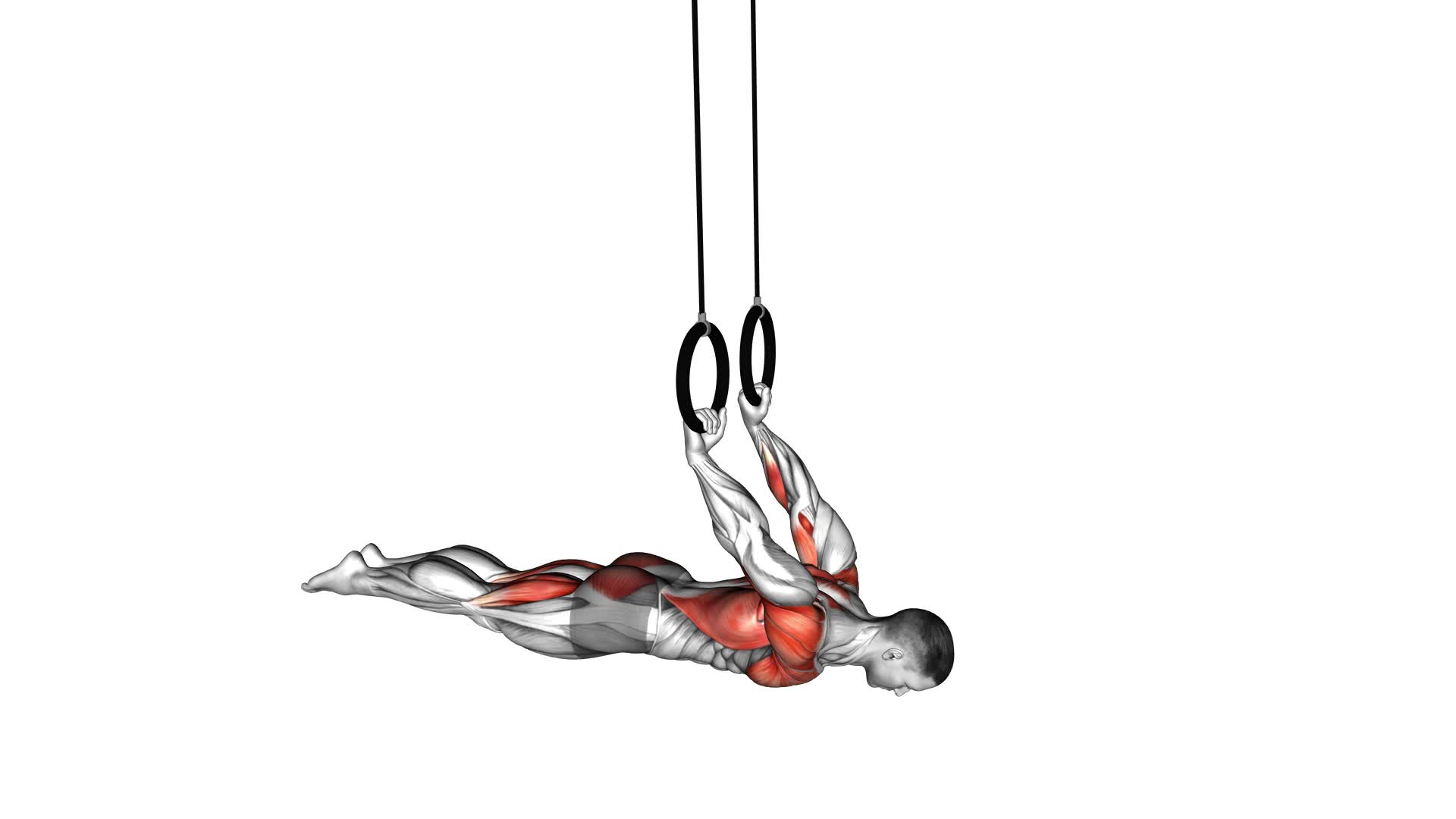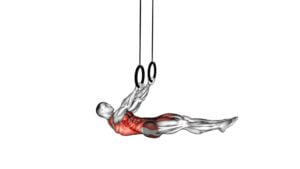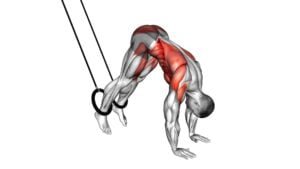Ring Back Lever (male) – Video Exercise Guide & Tips

Are you looking to take your fitness routine to the next level?
Watch This Exercise Video
The Ring Back Lever is a challenging exercise that targets your upper body and core muscles.
In this video exercise guide, we will walk you through the proper technique and form, as well as provide tips on how to avoid common mistakes.
With our expert tips and demonstrations, you'll be on your way to mastering the Ring Back Lever in no time.
Let's get started!
Key Takeaways
- The Ring Back Lever targets upper body, core, and back muscles, improving strength and stability.
- Maintaining proper technique and form, such as keeping elbows tucked in and engaging core muscles, is crucial for muscle activation and injury prevention.
- Engaging the core for stability, maintaining a neutral spine position, and breathing deeply and evenly are important for a strong and stable base.
- Progressions, variations, and proper body alignment can enhance the exercise's effectiveness and challenge muscles further.
Benefits of the Ring Back Lever
Discover the impressive benefits you can gain from incorporating the Ring Back Lever into your workout routine. The Ring Back Lever is a challenging exercise that targets your upper body, core, and back muscles. By performing ring back lever progressions and variations, you can experience significant improvements in strength, stability, and overall body control.
One of the key benefits of the Ring Back Lever is its ability to strengthen your upper body. As you hold your body parallel to the ground, your arms, shoulders, and chest muscles are engaged to support your weight. This exercise can help you develop stronger and more defined muscles in these areas.
Additionally, the Ring Back Lever is an excellent exercise for improving core strength. To maintain the proper position, your abs and lower back muscles must work together to stabilize your body. This can lead to a stronger and more stable core, which is essential for overall strength and balance.
Furthermore, incorporating ring back lever variations into your routine can challenge your muscles in different ways. By changing the grip or body position, you can target specific muscle groups and enhance your overall strength and flexibility.
Equipment and Set Up
To successfully perform the ring back lever, it's crucial to select the proper equipment and set up your workout area correctly. Choosing the right rings that can support your weight and provide stability is essential.
Additionally, setting the rings at the appropriate height and ensuring they're securely anchored will contribute to a safe and effective workout.
Proper Equipment Selection
Choose the appropriate equipment and set it up correctly to perform the Ring Back Lever exercise effectively. Proper equipment selection is crucial for both equipment maintenance and safety precautions. Ensure that the rings you're using are sturdy and securely attached to a stable structure, such as a pull-up bar or ceiling beams. Check the condition of the rings regularly to ensure there are no signs of wear or damage.
Additionally, make sure the height of the rings is appropriate for your body size and skill level. Setting up the equipment correctly won't only help you perform the exercise safely but also set you up for success as you progress in your training.
Setting up for Success
To set yourself up for success with the Ring Back Lever exercise, make sure you select and set up your equipment correctly. Before starting the exercise, ensure that you have a pair of rings securely attached to an overhead support, such as a pull-up bar or a sturdy beam. Adjust the height of the rings so that they're at chest level.
Once the rings are set up, position your body correctly to maximize the effectiveness of the exercise. Grab the rings with an overhand grip and hang with your arms fully extended. Keep your body straight and engage your core to maintain stability.
This exercise requires a great deal of upper body strength, so make sure you're properly warmed up and ready before attempting it.
Proper Technique and Form
To perform the Ring Back Lever with proper technique and form, it's important to pay attention to your elbows positioning. Keep them tucked in close to your body throughout the exercise to maintain stability and control.
Additionally, engage your core muscles to provide a strong base and prevent any excessive swinging or wobbling.
Following these points will help you execute the Ring Back Lever effectively and safely.
Elbows Positioning During Exercise
Maintain proper form and technique during the Ring Back Lever exercise by ensuring your elbows' positioning is correct. Proper alignment of your elbows is crucial for maximizing muscle activation and preventing injury.
When performing the Ring Back Lever, your elbows should be positioned directly under your shoulders. This alignment helps distribute the load evenly throughout your upper body and promotes stability. It also ensures that your triceps and other muscles surrounding the elbows are properly engaged, allowing for a more effective and efficient workout.
Avoid letting your elbows flare out to the sides, as this can strain the shoulder joints and decrease the effectiveness of the exercise. By maintaining proper elbow positioning, you can optimize your performance and achieve the best results from the Ring Back Lever.
Engaging Core for Stability
Engage your core for stability by contracting your abdominal muscles during the Ring Back Lever exercise. This core activation is essential to maintain proper body alignment and prevent any unnecessary strain or injury.
Here are four key points to keep in mind when engaging your core for stability:
- Start by drawing your belly button towards your spine. This activates your deep core muscles and helps create a strong foundation for the exercise.
- Maintain a neutral spine position throughout the movement. Avoid arching or rounding your back, as this can put excessive stress on your spine. Keep your core engaged to support a stable and aligned posture.
- Breathe deeply and evenly during the exercise. Proper breathing not only helps with core activation but also ensures adequate oxygen supply to your muscles, promoting better performance.
- Focus on maintaining a strong and stable core throughout the entire range of motion. This will enhance your overall body control and stability during the Ring Back Lever exercise.
Common Mistakes to Avoid
Ensure proper form by keeping your body straight and core engaged throughout the Ring Back Lever exercise. Avoiding common mistakes is crucial to prevent injuries and improve strength effectively.
One major mistake to avoid is arching your back during the exercise. This not only compromises your form but also puts excessive strain on your lower back, increasing the risk of injury. Remember to maintain a straight line from your head to your heels, engaging your core muscles to stabilize your body.
Another common mistake isn't properly engaging your shoulder blades. When performing the Ring Back Lever, it's essential to retract your shoulder blades and actively engage your upper back muscles. This helps to maintain stability and control throughout the exercise, preventing unnecessary strain on your shoulders and reducing the risk of injury.
Furthermore, avoid rushing through the exercise or using momentum to swing your body. The Ring Back Lever requires controlled movements and deliberate muscle engagement. Take your time to execute each rep with proper form and focus on the targeted muscles.
Lastly, it's important to avoid overextending your elbows during the Ring Back Lever. Hyperextending your elbows puts excessive stress on the joint, increasing the risk of injury. Maintain a slight bend in your elbows throughout the exercise to ensure proper joint alignment and reduce the risk of strain.
Progressions and Variations
To further challenge yourself and enhance your strength, there are various progressions and variations you can incorporate into your Ring Back Lever exercise routine. These advanced progressions and variations will help you take your training to the next level and continue to push your limits.
Here are four options to consider:
- One-arm Ring Back Lever: This variation requires you to perform the exercise with only one arm, increasing the demand on your upper body strength and stability.
- Straddle Ring Back Lever: In this variation, you widen your leg position into a straddle, creating a larger lever arm and increasing the difficulty of the exercise.
- L-sit Ring Back Lever: By extending your legs straight out in front of you, you create an L-shape with your body, challenging your core strength and overall stability.
- Ring Back Lever Pull-ups: Incorporating pull-ups into the exercise adds an extra challenge by combining the strength required for both exercises.
By incorporating these advanced progressions and variations into your routine, you can continue to challenge your body and improve your strength and stability.
Now, let's move on to some tips for mastering the ring back lever.
Tips for Mastering the Ring Back Lever
To continue improving your strength and stability while mastering the Ring Back Lever, consider implementing the following tips.
First, be aware of common errors that can hinder your progress. One common mistake isn't engaging your core muscles properly. To avoid this, focus on tightening your abs and squeezing your glutes throughout the movement. Another error isn't maintaining proper body alignment. Make sure your body is straight from head to toe, with your shoulders pulled back and down. Lastly, avoid rushing the movement. Take your time and focus on maintaining control and stability throughout each rep.
In addition to avoiding common errors, you can also challenge yourself with advanced variations of the Ring Back Lever. Once you have mastered the basic form, you can try lowering into a deeper back lever position or extending one leg straight out in front of you. These variations will increase the difficulty of the exercise and further strengthen your muscles. Remember to always prioritize proper form and control over intensity. It's better to perform the exercise correctly with proper technique than to rush through it and risk injury.
Frequently Asked Questions
How Long Does It Take to Master the Ring Back Lever?
To master the ring back lever, it takes time and dedication. Proper form is crucial to achieve this challenging exercise. Techniques like engaging your core, keeping your body tight, and focusing on pulling your legs up will help you progress.
Avoid common mistakes such as using momentum or not maintaining tension throughout your body. With practice and consistency, you'll gradually improve your strength and stability, eventually mastering the ring back lever.
Are There Any Specific Muscles Targeted During the Ring Back Lever?
When performing the ring back lever, there are specific muscles targeted. This exercise primarily works your back muscles, including the latissimus dorsi and rhomboids. Additionally, it engages your core muscles, such as the abs and obliques, for stability and control.
As for the progression timeline, it varies from person to person. It may take weeks or even months to master the ring back lever, depending on your current strength and training consistency.
Can the Ring Back Lever Be Modified for Beginners or Individuals With Limited Upper Body Strength?
Yes, the ring back lever can be modified for beginners or individuals with limited upper body strength.
There are various modified variations of the exercise that can help you build strength towards the full ring back lever. These modifications can include using bands for assistance, starting with shorter lever holds, or focusing on specific progressions exercises that target the muscles needed for the ring back lever.
With consistent practice and gradual progression, you can work your way up to performing the full exercise.
What Are Some Alternative Exercises That Can Help Improve Strength for the Ring Back Lever?
If you're looking for alternative exercises to improve strength for the ring back lever, there are a few options you can try.
Push-ups and pull-ups are great for building upper body strength.
Plank variations, like side planks and forearm planks, can also help strengthen your core and shoulders.
Additionally, practicing hanging leg raises and knee tucks can improve your grip strength and abdominal muscles, which are essential for the ring back lever.
Remember to start with modifications for beginners and gradually progress as you get stronger.
Is It Necessary to Have Gymnastics Rings to Perform the Ring Back Lever, or Can Other Equipment Be Used as Well?
To perform the ring back lever, you don't necessarily need gymnastics rings. Other equipment like TRX straps or suspension trainers can be used too. These alternatives provide similar resistance and stability.
However, it's important to note that modifications may be necessary for beginners or those with limited upper body strength. Gradually building strength and progressing to more challenging variations will help you eventually achieve the ring back lever.
Conclusion
In conclusion, the ring back lever is an effective exercise that targets the muscles of the upper body and core. With the proper equipment and technique, this exercise can help improve strength, stability, and body control.
By avoiding common mistakes and progressing gradually, you can master the ring back lever and experience its full benefits. Remember to consult a professional trainer for guidance and always listen to your body's limitations.
Keep practicing and enjoy the challenge of this advanced exercise.

Author
Years ago, the spark of my life’s passion ignited in my mind the moment I stepped into the local gym for the first time. The inaugural bead of perspiration, the initial endeavor, the very first surge of endorphins, and a sense of pride that washed over me post-workout marked the beginning of my deep-seated interest in strength sports, fitness, and sports nutrition. This very curiosity blossomed rapidly into a profound fascination, propelling me to earn a Master’s degree in Physical Education from the Academy of Physical Education in Krakow, followed by a Sports Manager diploma from the Jagiellonian University. My journey of growth led me to gain more specialized qualifications, such as being a certified personal trainer with a focus on sports dietetics, a lifeguard, and an instructor for wellness and corrective gymnastics. Theoretical knowledge paired seamlessly with practical experience, reinforcing my belief that the transformation of individuals under my guidance was also a reflection of my personal growth. This belief holds true even today. Each day, I strive to push the boundaries and explore new realms. These realms gently elevate me to greater heights. The unique combination of passion for my field and the continuous quest for growth fuels my drive to break new ground.







